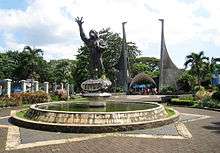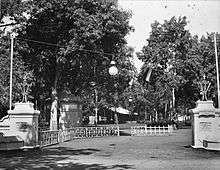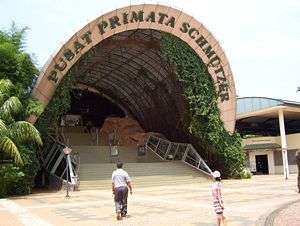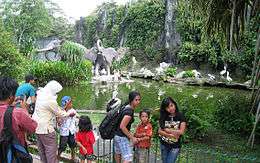Ragunan Zoo
 Front gate of the Ragunan Zoo | |
| Date opened |
1864 22 June 1966 (in current location) |
|---|---|
| Location | Pasar Minggu, South Jakarta, Indonesia |
| Coordinates | 6°18′42″S 106°49′12″E / 6.3115875°S 106.8199182°ECoordinates: 6°18′42″S 106°49′12″E / 6.3115875°S 106.8199182°E |
| Land area | 140 ha (350 acres) |
| Number of animals | 3,122 |
| Number of species | 270 |
| Memberships | WAZA[1] |
| Website | www.jakartazoo.org |
Ragunan Zoo is a 140-hectare (350-acre) zoo located in Pasar Minggu, South Jakarta, Indonesia. It is home to over 270 species of animals, 171 species of flora, and employs over 450 people.[2] Many of the animals are endangered and threatened from all parts of Indonesia and the rest of the world.[3] There are a total of 3,122 animal specimens including birds.[4] Laid out in a lush tropical setting, such indigenous animals as the Komodo dragon, orangutan, tapir, anoa, sumatran tiger, banteng wild ox and various brightly colored birds are given ample room. The zoo is located in South Jakarta and is easily accessible through the Jakarta Outer Ring Road and TransJakarta Corridor 6 bus (grey color).[5]
Ragunan Zoo has more than 150 year of age as the third oldest zoo in the world and set as second largest zoo in the world with the most diverse animals and plants population.[6]
Beginning in February 2014, the zoo will be closed every Monday for maintenance and to provide a quiet day for the animals. If Monday is a holiday, the zoo will be open but will be closed on another day in lieu of the holiday.[7]
History

The zoo was established in 1864 by a Dutch East Indies flora and fauna lovers organization, the Vereneging Plantenen Dierentuin of Batavia. Raden Saleh, a prominent Indonesian painter in the 19th century, donated about 10 hectares (25 acres) of his land for the establishment of Batavia first zoo in the Cikini area of Central Jakarta.[5] The zoo moved to its present location in 1966, and was officially opened on 22 June 1966, managed by the city administration. The former location was turned into the Taman Ismail Marzuki performing art center and Jakarta Art Institute.
On 19 September 2005, following the order of the city's governor, the zoo was closed temporarily for about three weeks after various birds were found to have contracted avian influenza.[8] It reopened on October 11.
On January 1, 2015 Ragunan Zoo was visited by 186,456 visitors, the highest among the New Year days, the previous highest record was about 175,000 visitors on January 1, 2011.[9]
In 2015, Ragunan Zoo will receive Rp 209 billion from local government as subsidy. Previous budget can use for operational costs only, but initial 2015, the budget is also sufficient to improve welfare of the animals. In 2018, Ragunan Zoo is predicted will has international standard, with hire experts to initial improving welfare of the animals, improving quality of the cages, and improving facilities for the visitors.[10]
The Schmutzer Primate Centre

The Schmutzer Primate Centre was opened in 2002, within the Ragunan Zoo but privately funded and managed separately. It is one of the largest of such centers in the world. The 13-hectare (32-acre) special enclosure houses various primates, including gorillas, chimpanzees and orangutans. The center was named after the late Pauline Antoinette Schmutzer, who donated her estate to the center.[5] Dr Willie Smits of the Borneo Orangutan Survival Foundation designed the orangutan enclosure so that the orangutans have as natural an environment as possible. Thick dark glass allows visitors to see the orangutans while being invisible to them.
Exhibits

The main attractions of the zoo are its animal exhibits. These may be grouped as follows.
- Reptiles
Two terrariums host venomous and non-venomous snakes, such as Asian reticulated phytons, albino pythons, and king cobras, as well as other reptiles including turtles. Large reptiles such as Komodo dragons are located in a separate compound while saltwater crocodiles and gavials are located in a simulated river valley wetland area.
- Mammals
Primate cages house several kinds of langurs, gibbons, and macaques, while gorillas, chimpanzees, and orangutans are located in the Schmutzer Primate Centre.
Small mammal compounds display raccoon, binturong, beaver, Asian palm civet, Java mouse-deer, Javan porcupine, and bats. Other mammals on display such as babirusa, tapir, llama, antelope, camel, Arabian oryx. Ragunan also hosts carnivore large cats such as tigers, leopards, and lions. The cage of Sumatran tigers, white Bengal tigers, American black bear, and sun bear located on southeastern end of the zoo near the lake.
- Birds
The pool with Australian pelicans, swans, and ducks located near the entrance. Several large aviary and smaller bird cages host the zoo's bird collection, including Javan peafowl, Indian peafowl including the white one, Javan hawk-eagle, brahminy kite, white-bellied sea eagle, crested serpent-eagle, Bali starling, lesser bird-of-paradise, palm cockatoo, common hill myna, flamingo, several kinds of hornbills, crowned pigeons, cockatoos, parrots, and pheasants. Large birds such as cassowary, emu, and ostrich are displayed in separate compounds.
- Open ranges
The river valley located on the eastern side of the zoo provides natural landscape of wetlands, swamp, and river environment that features crocodiles, gavial and hippopotamus. The eastern open plain recreates the savanna environment with various kinds of deers such as the rare Bawean deer, common muntjac, nilgai, and wild buffalo including Javan wild bull, and anoa.
- Other animals
Other popular animals on display are Sumatran elephant, kangaroo, giraffe, and zebra.
Other attractions
Special attractions for the children include a Children's Zoo, playground and rides, along with the Sunday events of elephant ride, pony cart and boat rides on Ragunan lake. Watching the orangutans on their daily tour of the zoo grounds in a pony cart. Restaurant facilities and picnic shelters are available for visitors convenience as well as stands for purchasing souvenirs of the zoo.
References
- ↑ "Zoos and Aquariums of the World". waza.org. WAZA. Retrieved 16 February 2011.
- ↑ Dina Indrasafitri, 'Ragunan zoo: Not so rosy', The Jakarta Post, 5 October 2010.
- ↑ However as is the case with other zoos in Indonesia, there is sometimes local criticism about the management of the zoo and whether animals are cared for in a proper way. See, for example, Corry Elyda, 'Visitors feel pity for Ragunan Zoo occupants', The Jakarta Post, 28 June 2013.
- ↑ Welcome to the Ragunan Zooligal Park
- 1 2 3 "Out & About: Ragunan Zoo: A gem in careless hands". Jakarta Post. 26 January 2010. Retrieved 2011-02-16.
- ↑ Ninis Chairunnisa (September 21, 2014). "Ragunan Zoo Mulls Safari Night".
- ↑ "Ragunan to give animals weekly day off". January 29, 2014.
- ↑ http://www9.sbs.com.au/theworldnews/region.php?id=120934®ion=2
- ↑ "Taman Margasatwa Ragunan Pecahkan Rekor Jumlah Pengunjung". January 1, 2015.
- ↑ Linda hairani (February 1, 2015). "Ragunan Zoo Set to Become International Standard Zoo in 2018".
External links
![]() Media related to Ragunan Zoo at Wikimedia Commons
Media related to Ragunan Zoo at Wikimedia Commons